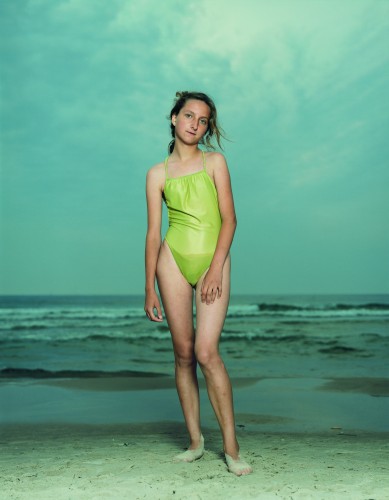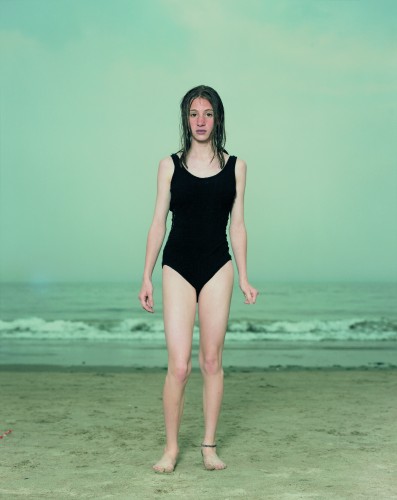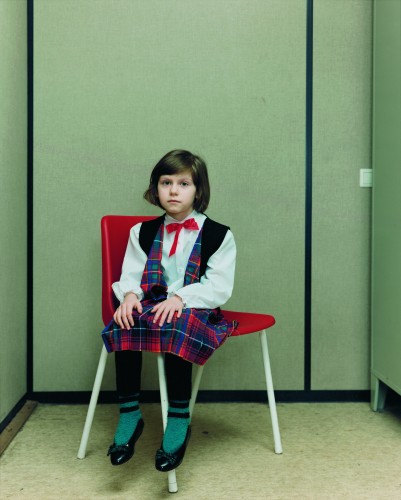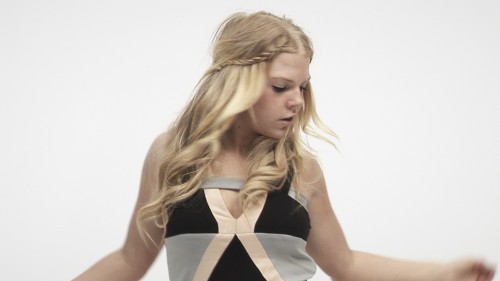
Rineke Dijkstra. "Kolobrzeg, Poland, July 26, 1992." Chromogenic print, 117 x 94 cm. Courtesy the artist and Marian Goodman Gallery, New York and Paris. © Rineke Dijkstra.
From the antique statue of the Kritios boy to Edward Weston’s photographic meditations on his son Neil and beyond, youth and its attendant qualities of beauty and innocence has fascinated artists for centuries. Rineke Dijkstra’s retrospective exhibition at the Guggenheim in New York affirms that the Dutch-born photographer is in many ways part of this enduring tradition. For Dijkstra, however, “youth” is not some timeless ideal, but a state of uncertain transition, and since the early 1990s she has produced a complex body of work that offers viewers a decidedly refreshing take on adolescence.

Rineke Dijkstra. “Dubrovnik, Croatia, July 13, 1996.” Chromogenic print, 117 x 94 cm. Courtesy the artist and Marian Goodman Gallery, New York and Paris. © Rineke Dijkstra.
Rineke Dijkstra: A Retrospective brings together some 70 photographs and five videos, and is installed to reflect the artist’s tendency to work in series. Beginning in 1992 Dijkstra, born in Sittard, the Netherlands in 1959, began a series of full-length portraits of primarily American and Eastern European youths standing at the edge of the sea, titled Beach Portraits (1992-2002). Employing a shallow focal plane and shooting from a low angle in settings offering little contextual detail, Dijkstra produced a set of carefully balanced compositions defined by the central, monumental presence of her youthful subjects. The classical simplicity of Dijkstra’s photographs focuses the viewer’s attention on the subtle particulars: the teens’ gawky, angular bodies, ill-fitting swimsuits and awkward postures.

Rineke Dijkstra. "Coney Island, N.Y., USA, June 20, 1993." Chromogenic print, 117 x 94 cm. Courtesy the artist and Marian Goodman Gallery, New York and Paris. © Rineke Dijkstra
Despite their leisurely backdrop of the beach, Dijkstra’s Beach Portraits would never be mistaken for magical idylls. Dijkstra’s portraits are fretful ones, her subjects tense with the uncertainty and diffidence that are hallmarks of adolescence. Her subjects hover somewhere between the receding past of their childhood and an unknown future. And while the identity of her subjects remain anonymous—each beach photograph is only identified by date and location—when viewed together a collective body emerges, one that stirs restlessly between the last physical and emotional trappings of youth and the social and psychological pressures of pending adulthood. The individuals depicted are so powerfully distinct that the effect of seeing these portraits en mass is symphonic, and the images begin to collectively hum with the sounds of the construction of self—its awkwardness, its uncertainty and above all, its heartbreakingly tender beauty.

Rineke Dijkstra. "Almerisa, Asylum Center Leiden, Leiden, Netherlands, March 14, 1994." Chromogenic print, 94 x 75 cm. Courtesy the artist and Marian Goodman Gallery, New York and Paris. © Rineke Dijkstra
Dijkstra’s concern with the themes of time and change is also on view in a series of works in which the artist repeatedly photographed people over the course of several months and years. One ongoing series, titled Almerisa, spans more than a decade, here represented with works dating from 1994 to 2008. Dijkstra first photographed Almerisa, a young Bosnian girl, when she was at a refugee camp seeking asylum in the Netherlands in 1994, as part of a project documenting the children of refugees. Subsequent photographs, about one taken each passing year, record Almerisa’s transition through adolescence and into adulthood, allowing us to regard the passage of innocence and ponder the vast forces that have impacted her in the intervals between sittings. Looking over Dijkstra’s episodic record of Almerisa’s physical transformation as it unfolds across the museum walls, we trace the course of what we can only imagine are her adjustments to the uncertainties of a refugee’s life, and the coming of age in a new place and culture.
The similar compositional format used by Dijkstra—in each image Almerisa is viewed frontally and seated in an interior setting—lends the Almerisa series an evening keel against the flux of time and change. Dijkstra’s signature understated approach allows us to reflect upon the outward signs of Almerisa’s assimilation and her transformation from a sweetly reticent child perched in a chair and whose feet don’t yet touch the ground, to a gangly and image-conscious adolescent to, finally it seems, a contented mother. A handful of images from across a decisive decade of life seems too few to be encyclopedic—and it is—but if closure seems elusive, the task of looking is incredibly satisfying, if at times bittersweet.
Since the mid-1990s Dijkstra has also used video to capture the coming-of-age angst and the fits and startsof adolescence, producing a series of works in which she filmed teenage subjects in English and Dutch dance clubs. One such work, Dijkstra’s multi-channel video installation The Krazyhouse (Megan, Simon, Nicky, Philip, Dee), Liverpool, UK (2009), shows five habitués of the famed Liverpool nightclub Krazyhouse (a club whose slogan is, fittingly, “The Night of Your Life”) dancing to their favorite music. Isolating her five precocious subjects from the dancehall crowds and filming them dancing alone against a white backdrop to the beats of techno and house music, Dijkstra draws our attention to the carefully calibrated rituals of non-verbal self-expression, self-definition and sexual tension playing out nightly in clubs through body language, dance moves and fashion. The Krazyhouse is a mesmerizing video installation, an irresistible chronicle of youthful energy and socialization as well as a meditation on the many rites of passage that must be navigated along the way.

Rineke Dijkstra. "The Krazyhouse (Megan, Simon, Nicky, Philip, Dee), Liverpool, UK, 2009." Four-channel HD video projection, with sound, 32 min., looped. Courtesy the artist and Marian Goodman Gallery, New York and Paris. © Rineke Dijkstra
Collectively, Dijkstra’s videos and photographs weave a surprisingly rich and complex tapestry of youth’s exuberant fantasies and restless realities, and give visual form to the parallel and conflicting pressures of fitting in and defining one’s self in contemporary culture. By documenting adolescents suspended at a point just before they finally find themselves and who they are in the world, Dijkstra’s photographs allow us to remember what it’s like to be young: the longing and insecurities as well as the limitless possibilities. But it is the ongoing Almerisa series that perhaps offers the most poignant reminder of what we all know awaits these adolescents on the cusp of adulthood: you grow up only to discover that that angst, uncertainty, and transforming sense of self never really ends.
Rineke Dijkstra: A Retrospective, is on view at the Solomon R. Guggenheim Museum in New York until October 8, 2012.




Pingback: Article: On View Now | Arresting Development: Rineke Dijkstra’s Retrospective Exhibition « design theory
Pingback: Exhibition: ‘Rineke Dijkstra: A Retrospective’ at the Solomon R. Guggenheim Museum, New York « Art Blart
Pingback: The Teen-Girl Tumblr Aesthetic | Nick Socrates Contemporary Art